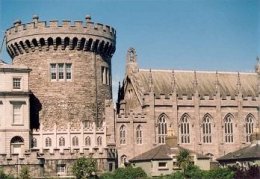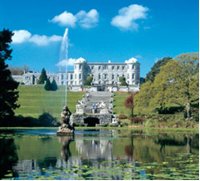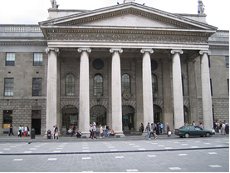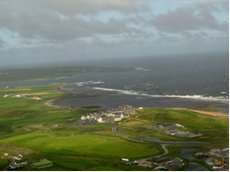|
Contact:
Marcus Greferath
School of Math. Sciences
University College Dublin
Belfield, Dublin 4, Ireland
Phone:
+353-1-716-2588 (UCD)
+353-85-153-0951 (mobile)
Joachim Rosenthal
Institut of Mathematics
University of Zurich
Winterthurerstrasse 190
8057 Zurich, Switzerland
Phone:
+41-44-63 55884 (office)
|
|
ITW 2010 Dublin
IEEE Information Theory Workshop
Dublin, August 30 - September 3, 2010
Local Information
Directions from/to Dublin Airport

 The airport is located 10 km north of Dublin city.
On arrival we recommend taking a bus called
the Aircoach.
This bus departs from right outside the airport
terminal - when you exit the airport building, the
bus stop is immediately on your left. The bus is
non-stop to O' Connell Street (city centre north)
and thereafter stops at Grafton Street / Trinity
College (city centre south). Grafton Street is the
Aircoach bus station closest to the conference hotel
(see map). The cost is €7
one way, €12 return.
The airport is located 10 km north of Dublin city.
On arrival we recommend taking a bus called
the Aircoach.
This bus departs from right outside the airport
terminal - when you exit the airport building, the
bus stop is immediately on your left. The bus is
non-stop to O' Connell Street (city centre north)
and thereafter stops at Grafton Street / Trinity
College (city centre south). Grafton Street is the
Aircoach bus station closest to the conference hotel
(see map). The cost is €7
one way, €12 return.
 Another possibility is taking the Dublin Bus
Airlink
Service, which offers a non-stop connection from the
Airport to O' Connell Street
(see map). Here you can
change for Aungier street (close to the conference
hotel, bus stop 16, 16A, 19, 19A). We recommend to
buy a one day rambler ticket (€6) at the tourist
information desk in the airport arrival hall - this
way you can use Dublin buses the whole day. To get
to the Airlink bus stop exit the airport building,
cross the road at the traffic light, and the bus
stop is on your left.
Another possibility is taking the Dublin Bus
Airlink
Service, which offers a non-stop connection from the
Airport to O' Connell Street
(see map). Here you can
change for Aungier street (close to the conference
hotel, bus stop 16, 16A, 19, 19A). We recommend to
buy a one day rambler ticket (€6) at the tourist
information desk in the airport arrival hall - this
way you can use Dublin buses the whole day. To get
to the Airlink bus stop exit the airport building,
cross the road at the traffic light, and the bus
stop is on your left.
You can also take a taxi from the airport. From
the airport to a city centre Hotel the fare will be
roughly about €30 (this is a guess).
Conference hotel
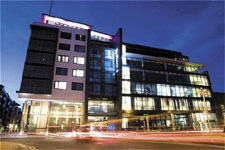 Radisson Blu Royal Hotel
Radisson Blu Royal Hotel
Golden Lane
Dublin 8, Ireland
Tel: +353-1-898-2900
The conference hotel is located in the center of
Dublin, close to Dublin Castle, St. Patrick's park,
and Grafton Street. The hotel is marked in red on
the map, where you also find
the nearest bus stops (Grafton Street / Trinity
College for the Aircoach, Aungier Street for Dublin
Bus).
About Dublin
 Dublin,
the capital of the Republic of Ireland, is built on
the River Liffey and has a population of about
500,000 people (1,050,000 in the urban area). It is
situated beside the sea, and close to the
countryside and mountains. The rest of the country
is easily accessible by car, train, or bus.
Ireland, with its beautiful scenery, offers a range
of attractions to the tourist including ancient
archaeological sites and monuments, a variety of
sporting activities such as fishing, riding and
golf, as well as traditional dancing and music. Dublin,
the capital of the Republic of Ireland, is built on
the River Liffey and has a population of about
500,000 people (1,050,000 in the urban area). It is
situated beside the sea, and close to the
countryside and mountains. The rest of the country
is easily accessible by car, train, or bus.
Ireland, with its beautiful scenery, offers a range
of attractions to the tourist including ancient
archaeological sites and monuments, a variety of
sporting activities such as fishing, riding and
golf, as well as traditional dancing and music.
A city of fine Georgian buildings, Dublin has been
influenced by its Danish, Norman and English
antecedents. It has excellent shops, museums,
antique shops and a range of pubs and restaurants.
It has four major theatres, including the world
famous Abbey theatre, concert facilities, art
galleries and cinemas. There is a wide variety of
sporting facilities including golf courses and
sailing, as well as racecourses. For more
information about Dublin see
www.visitdublin.com.
Return to conference mainpage
|
|



 Dublin,
the capital of the Republic of Ireland, is built on
the River Liffey and has a population of about
500,000 people (1,050,000 in the urban area). It is
situated beside the sea, and close to the
countryside and mountains. The rest of the country
is easily accessible by car, train, or bus.
Ireland, with its beautiful scenery, offers a range
of attractions to the tourist including ancient
archaeological sites and monuments, a variety of
sporting activities such as fishing, riding and
golf, as well as traditional dancing and music.
Dublin,
the capital of the Republic of Ireland, is built on
the River Liffey and has a population of about
500,000 people (1,050,000 in the urban area). It is
situated beside the sea, and close to the
countryside and mountains. The rest of the country
is easily accessible by car, train, or bus.
Ireland, with its beautiful scenery, offers a range
of attractions to the tourist including ancient
archaeological sites and monuments, a variety of
sporting activities such as fishing, riding and
golf, as well as traditional dancing and music.